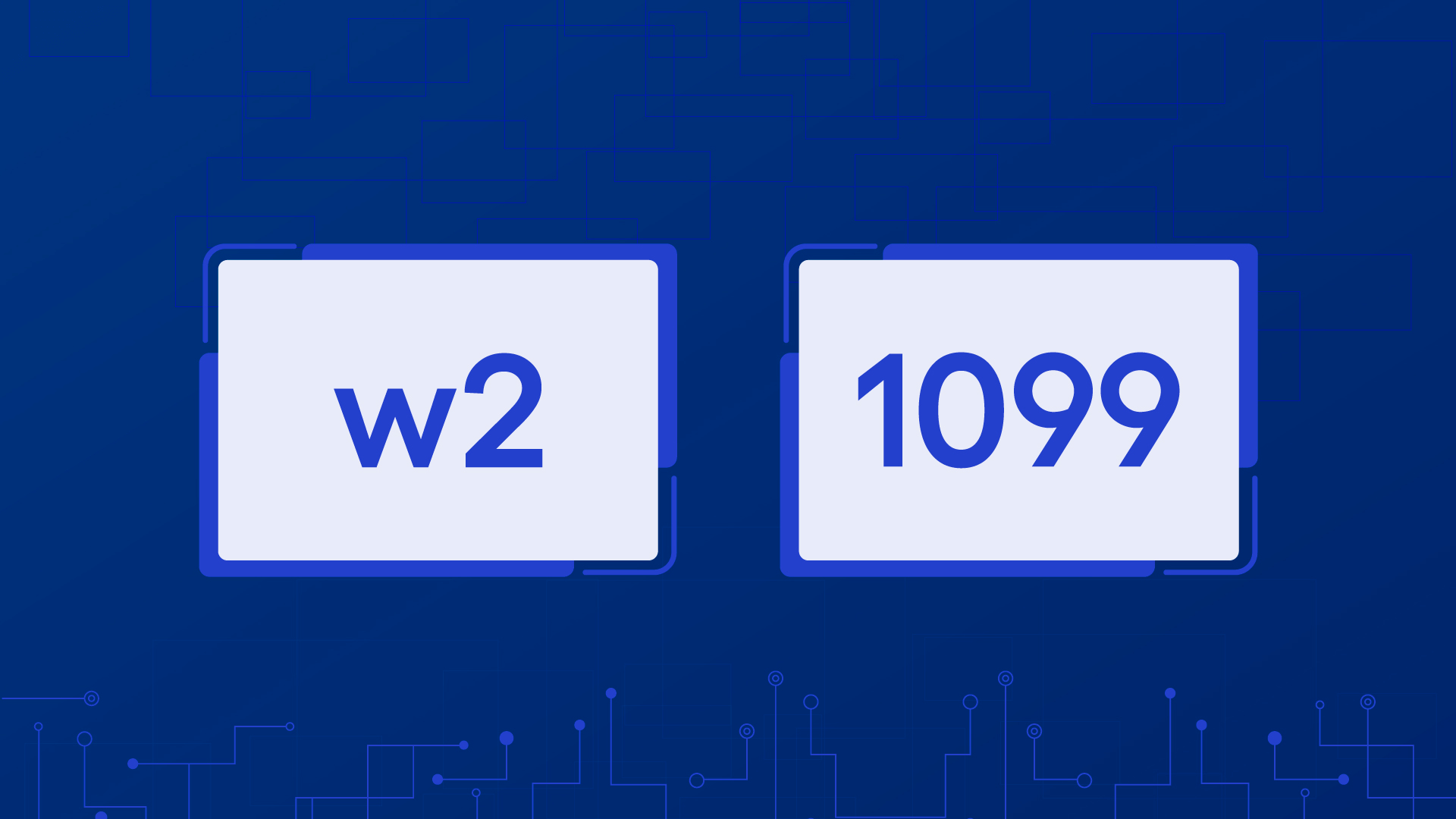Are you struggling to figure out the difference between W-2 and 1099?
1099 vs. W-2 can be confusing.
There are chances you may get overwhelmed with the complexities. So, try to understand the basics first.
Have a clear understanding of classifying workers – whether they are employees or independent contractors. This is because it impacts the way how you and they are taxed. For instance, you must withhold and pay Social Security and Medicare taxes for employees only, not independent contractors.
Also, unless you are clear about the difference between W-2 and 1099, how can you know which one would be the best fit for your business?
So, let’s get started with 1099 vs. W-2!
Why should you know the difference between W-2 and 1099?
Here’s why understanding the difference between W-2 and 1099 is important.
If you misclassify an employee as an independent contractor, you might have to bear penalties from the IRS.
Employee classification determines the extent of control over the worker’s payment, schedule, and other job aspects. For employees, you set the schedule and policies. But independent contractors decide on their own how and when to work.
Taxes are affected by the difference between 1099 vs. W-2 employees. You need to withhold and pay income taxes on the compensation of W-2 employees. But the same does not apply to independent contractors.
So, getting an answer to ‘what is the difference between W-2 and 1099’ is important!
Who is a W2 worker?
To state simply, a W-2 employee is a regular salaried employee in a business.
W-2 workers are not like 1099 independent contractors. The difference between W-2 and 1099 is that the W-2 workers do not own a business. They work for your business and are entitled to employee benefits.
Also, W-2 workers work according to your business schedule and requirements.
Things to know about W-2 Forms
When getting started with the difference between W-2 and 1099, it is essential to know about the 1099 form vs. W-2 forms.
A W-2 form is a document that employers must send to their employees each year. This form is used to report the wages paid to employees in a year. So, employers must provide W-2 forms to each employee and the IRS.
The W-2 form includes information related to taxation that includes:
- State Income: The amount withheld for state income taxes, if any.
- Taxable Income: The amount earned by an employee and the part withheld for federal taxes
- Social Security and Medicare Income: The amount withheld for FICA taxes
Besides, knowing about the information that is included in W-2 forms there are certain factors that are a must-know for you.
- The W-2 forms determine whether an individual is getting a refund or paying during the taxation season.
- A W-2 form is different from a W-4 form. It is used to communicate how much tax you will withhold from your employees’ paycheck during each period
- As an employer, you must provide your employees with copies of W-2 forms by the end of January every year.
The information related to the first paycheck till the final one of the year comes from W-2 forms. When you provide employees with W-2 forms, they get an overview of their earned wages, withheld taxes (if any), and deductions for items like health insurance or retirement contributions for a specific period.
Now, what’s important to know is who gets the W-2 form.
So, the W-2 form is given to any employee who earns a minimum amount of $600 from an employer. This is regardless of the type of work performed. The employers, then, must file W-2 forms to the IRS, SSA, and local and state taxation authorities, wherever applicable.
Employers must withhold income tax and the employee part of the Social Security and Medicare taxes. The Medicare, Social Security, and FUTA taxes are to be paid by the businesses.
Pros and cons of hiring employees and independent contractors
Everything has pros and cons. So does hiring independent contractors and employees. This section lists out the pros and cons of 1099 vs. W-2 employees.
| Pros | Cons | |
| Employees |
|
|
| Independent contractors |
|
|
What is Form 1099 NEC?
This is one important aspect to be covered when you are learning about 1099 vs. W-2.
The 1099-NEC forms are used to report the Non-Employee Compensation or NEC. The form came into being in 2020.
The IRS now requires businesses/ employers to use the 1099-NEC form to report any amount paid to individuals who provided their services but were not the employees of the firm.
However, the amount paid must be a minimum of $600 in rents, services, or awards and prizes, and other income payments to qualify for the Form 1099-NEC.
A few common examples of non-employee compensation include the professional fees paid for services like accounting or taxation to 1099 independent contractors.
If you are thinking about who gets the 1099-NEC form, then let us tell you that any 1099 independent contractor or freelancer whom you pay more than $600 for their services must be provided with Form 1099-NEC for taxation purposes.
Things to know about 1099-NEC Forms
Besides these pros and cons of 1099 contractor vs. W-2, here are the answers to three crucial questions that you must know.
Can a worker be both a 1099 and a W-2?
As per IRS guidelines, a worker can be both a 1099 and W-2 employee as long as the duties performed by the individual are entirely different and would qualify them as independent contractors.
There are several examples to show how a worker can be both a 1099 and a W-2. Here they are:
- An IT manager who also provides website development services to local businesses post-work hours. The local companies contract with the individual to build their company websites.
- An administrative officer also owns a security services business in a partnership with their friend. The company contracts with the administrative officer to provide security guards at the office after working hours.
What are 1099-MISC forms?
A 1099-MISC form is used for reporting the miscellaneous income that does not fall into other categories of 1099.
Since 1099-NEC is now being used for reporting the non-employee compensation there have been revisions in Form 1099-MISC. The box numbers in the form have been shuffled to report certain income.
Take a look at the revised box numbers and what they are for.
- Box 7 – Check the box if the payer makes direct sales of $5000 or more
- Box 9 – Report crop insurance proceeds here
- Box 10 – Report the gross proceeds to an attorney in Box 10
- Box 12 – Report Section 409A deferrals here
- Box 14 – Report the non-qualified deferred compensation income here.
- Boxes 15, 16, and 17 – These boxes include withheld state taxes, state identification numbers, and the income amount earned in the state.
Who gets form 1099-MISC?
1099-MISC is to be provided to each individual whom an employer has paid during the year. The payments include:
- Minimum $10 in royalties or broker payments instead of tax-exempt interest or dividends.
- Minimum $600 in rents, other income payments, prizes or awards, payments to an attorney, medical and health care payments, cash payment made for fish (or any other aquatic life) purchased from anyone trading in catching fish, any proceeds from fishing boats and crop insurance.
Plus, you are to use Form 1099-MISC if you have made direct sales of a minimum of $5000 of consumer products to a buyer for the purpose of resale anywhere except a permanent retail establishment.
When to issue 1099 and W2 forms?
As an employer, it is important for you to know that taxpayers must issue and mail out all Forms 1099-NEC and 1099-MISC by no later than February 1st (if January 31st is a weekend like this year).
Besides this, employers must also take note that the new rule requires them to compile all of their 1099-NEC forms along with 1096 and mail them to the IRS by February 1st as well.
Note: According to the old rule, the date for sending the forms to the IRS was the end of February
In the case of W-2 forms, the IRS requires the employers to furnish the forms to the employees and the government by January 31st. By ‘furnish’, the IRS means sending it via mail. Hence, employees must have their W-2 forms by the first week of February.
How to submit 1099-NEC forms easily?
After you have completed the 1099-NEC form by:
- Posting the contractors (or non-employee) compensation to Box 1 on Form 1099-NEC
- Listing recipient’s TIN (Taxpayer Identification Number), name, and address;
- Recording any state and federal income tax withholdings (if applicable)
You will need to submit the 1099-NEC forms. Here, employers are required to provide several copies of the form to different recipients.
- First off, submit Copy A to the IRS along with Form 1096. Form 1096 reports all 1099 forms issued to independent contractors and the total amount of payments made.
- Secondly, send Copy 1 to the state department of revenue
- Next, employers must provide Copy B to the recipient, that is, the independent contractor.
- Lastly, keep a Copy C of the form for your business records. This will help in documenting the wage expenses that the firm posts on tax returns.
Difference Between 1099 and W-2 Employee
In the quest to understand W-2 vs. 1099, it is crucial to know the differences between 1099 and W-2 Employees. So, here they are.
| W2 | 1099 |
| Employees may or may not have the expertise for the work | Contractors are experienced |
| Stay in company for longer periods | Have short-term contracts |
| Employees are entitled to country-based benefits and require training at times. | More cost effective without any need of training or employee benefits |
| W-2 employees require your time, supervision, and management. | Contractors do not need to be managed. They decide their way of work and schedule. |
| Employees are required to be given all resources and processes for performing their work. | Contractors work independently without the necessity of too many resources from the business. |
| Employee taxes are to be withheld and paid by the employer. | 1099 contractor pays their taxes |
Difference Between Employee and Independent Contractor
Is a worker 1099 or a W-2 employee?
Having an answer to this question is a must before you can start with employee classifications.
Employee classifications require you to identify the difference between W-2 and 1099, which is vital for taxation purposes. The classification of a worker affects how you pay the employer taxes and how they pay their taxes like income tax, social security, and Medicare.
So, to help you classify a worker as a 1099 or W-2 employee, here are three categories of relevant facts that apply to the W-2 and 1099 difference.
1. Behavioral control
This category demonstrates your extent of control or your right to direct the worker on completing their job. If the employer has a right to control the task completion, it is an employee. On the other hand, if the employer has less to no direct control over the work, the worker is an independent contractor.
Here are a few sub-categories under behavioral control.
- Training: Employees get training about how a certain work is to be done. They are trained about the required processes, and methods. This indicates that the worker has to get the work done in a certain way. But contractors typically use their own ways and methods.
- Instruction type & degree: Employees receive extensive instructions like when to work, where, how, what tools to use, performing the work, etc. Whereas, independent contractors receive fewer instructions about the work. They are generally informed about the vitals only.
- Evaluation: For employees, the evaluation system examines the details of how the work has been performed. For contractors, only the result is measured.
2. Financial control
Financial control determines whether an employer can rightly control the economic aspect of a worker’s job.
Here are the categories related to financial control.
- Investments: Contractors make significant investments in resources to complete their tasks. But employees are provided with all the resources.
- Profit & loss opportunities: The chance of incurring a loss due to significant investments in equipment and other resources suggests that the worker is a contractor.
- Payment method: Employees are generally paid monthly. Contractors might be paid hourly, bi-monthly, or they might also charge a flat fee for the job.
- Available services: Contractors serve multiple businesses. They often advertise their work in the market as they look for additional business opportunities.
- Unreimbursed expenses: Most independent contractors have unreimbursed expenses. However, a few employees might also have unreimbursed expenses related to their services.
3. Type of relationship
This category of classification depicts the worker-employer relationship. The factors here include:
- Employee benefits: Contractors do not get the luxuries of insurance, paid vacation, pension schemes, etc. But employees are entitled to these benefits.
- Written contracts: Written contracts are not enough to determine the status of the worker. The way both the employer and the worker work together determines whether the worker is an employee or an independent contractor.
- Services offered: If a worker provides services that are a key aspect of the business, the employer will have a right to control. This indicates an employer-employee relationship.
- Relationship status: If you hire a worker with the expectation that the relationship will exist indefinitely or for the long term, it suggests that the intention is to create an employer-employee relationship. On the contrary, if the relationship is for achieving some short-term goal, the worker is an independent contractor.
Salary and benefit rate differences for W2 employees and 1099 contractors
The pay rate for W2 and 1099 categories vary depending on the industry sector, kind of work involved, qualifications, years of experience they own, and of course, the expertise and skill. Usually, the 1099 contractors pay per hour is more for these reasons:
- They are experts in their field
- They are responsible for paying their taxes
- They do not receive any other benefits, for instance, health insurance
Altogether, it’s the employer’s purview to evaluate and finalize the compensation of W2 and 1099 contractors.
1099 vs. W-2 Employee: Which One Should You Hire?
Getting the right staff in an organization is by far one of the most important and hectic tasks. As an employer, you must find the right fit for a role to ensure the best results for your business. So, hiring the best possible workers is quite a challenge.
Here’s a quick recap of 1099 vs W-2 employees.
- 1099 workers or independent contractors: When you have specific projects to be done, hire a 1099 independent contractor. Make sure that you are okay with not being able to control how they get their work done. You will not be responsible for providing them with employee benefits schemes like W-2 workers. Plus, you will not be responsible for covering their Social Security taxes and Medicare. So, 1099 independent contractors are an inexpensive option for you to get that project done on time.
- W-2 workers or company employees: W-2 employees need extensive management. They are your responsibility. They need a regular salary and are entitled to employee benefits like pension, health insurance, paid leave, etc. To get your everyday work done or for long-term projects, you might prefer hiring employees over independent contractors. Why so? Because having employees will let you control their work, supervise them, and train them as per your requirements.
To decide between hiring an employee or an independent contractor you must weigh the two options and our requirements.
Here are a few questions that you must get an answer to before you decide.
- What is the type of work that you need to get done?
- When is the deadline for the job submission?
- Is the job one time or is it a regular commitment?
- What are the costs related to hiring 1099 vs. W-2 employees?
So, answer these questions or consult a professional to help you make the final decision. Make sure that your company’s workforce is your competitive advantage.
Does it all seem Too Complicated? There’s a Way Out…
Are you struggling to understand all these differences between 1099 and W-2 forms? Employers already have so much on their plates. How are they supposed to take care of all these technical details? The best way to handle it all is by getting an automated onboarding tool called Multiplier.
Now you may ask why? Here’s how it helps you:
- Generating compliant contracts with minor inputs from the employer
- Simplifies global payroll and expedites the freelancer payment process
- It helps you manage and monitor all freelancers under a single dashboard
- Ensures benefits for freelancers and independent contractors
Want more information? Start your free demo now!







